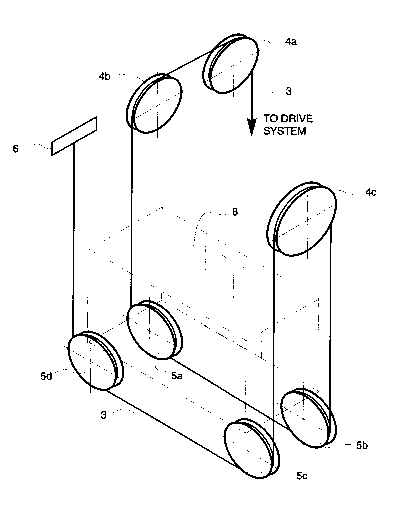Une partie des informations de ce site Web a été fournie par des sources externes. Le gouvernement du Canada n'assume aucune responsabilité concernant la précision, l'actualité ou la fiabilité des informations fournies par les sources externes. Les utilisateurs qui désirent employer cette information devraient consulter directement la source des informations. Le contenu fourni par les sources externes n'est pas assujetti aux exigences sur les langues officielles, la protection des renseignements personnels et l'accessibilité.
L'apparition de différences dans le texte et l'image des Revendications et de l'Abrégé dépend du moment auquel le document est publié. Les textes des Revendications et de l'Abrégé sont affichés :
| (12) Brevet: | (11) CA 2106436 |
|---|---|
| (54) Titre français: | TRANSMISSION A CABLE POUR CAGE D'ASCENCEUR, A RAPPORT QUATRE POUR UN |
| (54) Titre anglais: | FOUR TO ONE TRANSMISSION RATIO ROPE ARRANGEMENT FOR AN ELEVATOR CAR |
| Statut: | Durée expirée - au-delà du délai suivant l'octroi |
| (51) Classification internationale des brevets (CIB): |
|
|---|---|
| (72) Inventeurs : |
|
| (73) Titulaires : |
|
| (71) Demandeurs : |
|
| (74) Agent: | G. RONALD BELL & ASSOCIATES |
| (74) Co-agent: | |
| (45) Délivré: | 1997-05-06 |
| (22) Date de dépôt: | 1993-09-17 |
| (41) Mise à la disponibilité du public: | 1994-03-19 |
| Requête d'examen: | 1994-05-26 |
| Licence disponible: | S.O. |
| Cédé au domaine public: | S.O. |
| (25) Langue des documents déposés: | Anglais |
| Traité de coopération en matière de brevets (PCT): | Non |
|---|
| (30) Données de priorité de la demande: | ||||||
|---|---|---|---|---|---|---|
|
Une transmission à câble pour un ascenseur possède au moins deux paires de poulies de support montées sous la cage d'ascenseur, et au moins deux poulies de dérivation montées sur une paroi de la cage d'ascenseur. Les câbles de levage passent sous les poulies de support pour supporter la cage d'ascenseur, et sur les poulies de dérivation de telle manière que le rapport de transmission entre la vitesse de l'ascenseur et la vitesse de rotation de l'appareil de levage soit au moins 1:4.
A rope arrangement for an elevator has at least two pairs of support pulleys mounted under the elevator car, and at least two diverter pulleys mounted on a wall of the elevator shaft. The hoisting ropes run under the support pulleys to support the elevator car, and over the diverter pulleys in such a manner that the transmission ratio between the speed of the elevator car and the rotational speed of the hoisting machine is at least 1:4.
Note : Les revendications sont présentées dans la langue officielle dans laquelle elles ont été soumises.
Note : Les descriptions sont présentées dans la langue officielle dans laquelle elles ont été soumises.

2024-08-01 : Dans le cadre de la transition vers les Brevets de nouvelle génération (BNG), la base de données sur les brevets canadiens (BDBC) contient désormais un Historique d'événement plus détaillé, qui reproduit le Journal des événements de notre nouvelle solution interne.
Veuillez noter que les événements débutant par « Inactive : » se réfèrent à des événements qui ne sont plus utilisés dans notre nouvelle solution interne.
Pour une meilleure compréhension de l'état de la demande ou brevet qui figure sur cette page, la rubrique Mise en garde , et les descriptions de Brevet , Historique d'événement , Taxes périodiques et Historique des paiements devraient être consultées.
| Description | Date |
|---|---|
| Inactive : Périmé (brevet - nouvelle loi) | 2013-09-17 |
| Inactive : CIB de MCD | 2006-03-11 |
| Lettre envoyée | 2003-04-01 |
| Lettre envoyée | 1998-08-26 |
| Lettre envoyée | 1997-09-22 |
| Accordé par délivrance | 1997-05-06 |
| Exigences pour une requête d'examen - jugée conforme | 1994-05-26 |
| Toutes les exigences pour l'examen - jugée conforme | 1994-05-26 |
| Demande publiée (accessible au public) | 1994-03-19 |
Il n'y a pas d'historique d'abandonnement
| Type de taxes | Anniversaire | Échéance | Date payée |
|---|---|---|---|
| TM (brevet, 5e anniv.) - générale | 1998-09-17 | 1997-08-15 | |
| TM (brevet, 6e anniv.) - générale | 1999-09-17 | 1998-08-12 | |
| TM (brevet, 7e anniv.) - générale | 2000-09-18 | 2000-08-09 | |
| TM (brevet, 8e anniv.) - générale | 2001-09-17 | 2001-08-15 | |
| TM (brevet, 9e anniv.) - générale | 2002-09-17 | 2002-08-14 | |
| Enregistrement d'un document | 2003-02-28 | ||
| TM (brevet, 10e anniv.) - générale | 2003-09-17 | 2003-08-13 | |
| TM (brevet, 11e anniv.) - générale | 2004-09-17 | 2004-08-16 | |
| TM (brevet, 12e anniv.) - générale | 2005-09-19 | 2005-08-17 | |
| TM (brevet, 13e anniv.) - générale | 2006-09-18 | 2006-08-17 | |
| TM (brevet, 14e anniv.) - générale | 2007-09-17 | 2007-08-15 | |
| TM (brevet, 15e anniv.) - générale | 2008-09-17 | 2008-08-13 | |
| TM (brevet, 16e anniv.) - générale | 2009-09-17 | 2009-09-04 | |
| TM (brevet, 17e anniv.) - générale | 2010-09-17 | 2010-09-02 | |
| TM (brevet, 18e anniv.) - générale | 2011-09-19 | 2011-09-02 | |
| TM (brevet, 19e anniv.) - générale | 2012-09-17 | 2012-09-07 |
Les titulaires actuels et antérieures au dossier sont affichés en ordre alphabétique.
| Titulaires actuels au dossier |
|---|
| KONE CORPORATION |
| Titulaires antérieures au dossier |
|---|
| JOHANNES DE JONG |